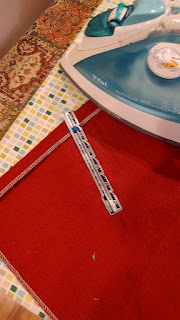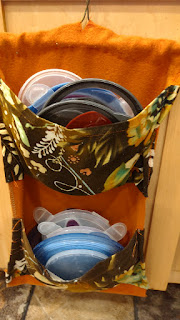I find that store-bought organization containers never fit the space I have and just collect junk. I am, however, a big fan of custom-made items. Over the past few years, I have made several items I call chaos reducers. They are fabric pockets or baskets in the exact size I need them. I have made chaos reducers for television remotes, jar lids, pencils and plastic container lids.
About a week ago I was looking in the cabinet that houses my blender, food processor and other items and I saw, well, chaos. I have too much fabric and that is also creating chaos. So, I decided to feed two birds with one scone (because who actually wants to kill birds) so I whipped up a quick project to hang the grating and food processor slicing discs.
I used an upholstery sample approximately 11.5 inches wide and 16.5 inches long with grommets pre-installed. The edges were already serged. For some reason, I really wanted the serged edges to be visible. Plus I didn't have enough width for a gusset construction, so I used construction techniques that might cause someone more expert to look askance.
I started the project by laying down the two blades and folding the fabric to roughly fit and marking the fabric. The pockets needed depth but the fabric was not wide enough so I cut a strip 2 inches wide from the bottom. I then cut the strip in half so had two about 2 inches wide and 5.25 inches long.
Then I folded the bottom of the rectangle up and I stitched on the other side of the stip from the inside. I could not stitch all the way down without catching parts of the pocket I didn't want to catch. Then I hung it on the fridge to test it. It gaped like crazy!
That reduced the gaping quite a bit. I then hung the chaos reducer inside the cabinet using Command hooks and rearranged the items. Now everything fits and is more organized.










.png)































%20v3.png)
%20v3.png)
